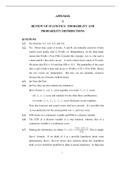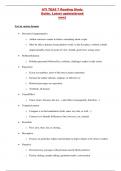1 APPENDIX A REVIEW OF STATISTICS: PROBABILITY AND PROBABILITY DISTRIBUTIONS QUESTIONS A.1. See Sections A.2, A.4, A.5, and A.6. A.2. No. Notice that a pair of events, A and B, are mut ually exclusive if they cannot occur jointly, that is, P(AB) = 0. Independence, on the other hand, means that P(AB) = P(A) P(B). Consider this example. Let A = the card is a heart and B = the card is an ace. A card is dra wn from a deck of 52 cards. We know that P(A) = 1/4 and that P(B) = 1/13. The probability of the event that a card is both a heart and an ace is P(AB) = 1/52 = P(A) P(B). Hence the two events are independent. But they are not m utually exclusive because the ace of hearts could be drawn. A.3. ( a) True, (b) True. A.4. ( a) Yes, they are also collectively exhaustive. ( b) (i) Events E1 and A2 occur together, ( ii ) events E3 or A3 occur, ( iii ) E1 or A1 occur and similarly for the other three combination s; ( iv ) events E2A1, E3A2, E4A3 occur (Each pair occurs together). Note that forecasts and actual events need not coin cide. It is possible that E1was predicted, but the actual growth was A 4and vice versa. A.5. PDF relates to a continuous variable and PMF to a d iscrete variable. A.6. The CDF of a discrete variable is a step function, whereas that of a continuous variable is a continuous curve. A.7. Making the substitution, we obtain P(A|B)=P(B|A)P(A)
P(B). This is simply Bayes ’ formula. If we think of A as a possible hypothesis about some phenomenon, Bayes’ theorem shows how opinions about this hypothesis held a priori should be modified in light of actual experience. In Bayesian 2 language, P(A) is known as prior probability and P(A|B) is known as posterior (or revised) probability. PROBLEMS A.8. ( a) xi−1
i=14
∑ = x0 + x + x2 + x3 (Note: x 0 = 1). (b) ayi
i=26
∑ =a yi=a(y2+y3+y4+y5+y6)
i=26
∑ (c) (2xi+3yi
i=12
∑)=2xi+3yi
i=12
∑
i=12
∑ =2(x1+x2)+3(y1+y2) (d) xiyi
j=12
∑
i=13
∑ =x1y1+x2y1+x3y1+x1y2+x2y2+x3y2 (e) i+4
i=14
∑ =i+
i=14
∑4
i=14
∑ = (1 + 2 + 3 + 4) + (4)(4) = 26 (f) 3i
i=13
∑ =3+32+33 = 39 (g) 2
i=110
∑ = (2)(10) = 20 (h) (4x2−3)
x=13
∑ =4x2−3
x=13
∑
x=13
∑ =4(12+22+32)−(3)(3) = 47 A.9. ( a) xi
i=15
∑ ( i from 1 to 5) (b) i xi
i=15
∑ (i from 1 to 5) (c) (xi2+yi2)
i=1k
∑ ( i from 1 to k) A.10. ( a) [500 (500 + 1)] / 2 = 125,250 (b) k−k
19
∑
1100
∑ = [100 (101)] / 2 – [9 (10)] / 2 = 5,005 3 (c) 3k
10100
∑ = 3(5,005) = 15,015, using (b) above. A.11. ( a) [10 (11)(21)] / 6 = 385 (b) k2
120
∑ −k2=20(21)(41)
619
∑ −9(10)(19)
6 = 2,585 (c) k2
119
∑ −k2=19(20)(39)
6110
∑ −10(11)(21)
6= 2,085 (d) 4k2
110
∑ = 4(385) = 1,540, using (a) above. A.12. ( a) Since ∑ )f( X = 1, ( b + 2 b + 3 b + 4 b + 5 b) = 15 b = 1. Therefore, we have b = 1/15. (b) P(X ≤ 2) = 6/15; P(X ≤ 3) = 10/15; P(2 ≤ X ≤ 3) = 4/15 A.13. ( a) Marginal distributions: X 1 2 3 Y 1 2 3 4 f(X) 0.20 0.40 0.40 f(Y) 0.15 0.10 0.45 0.30 (b) Conditional distributions: f(X|Y) f(Y|X) P(X = 1 | Y = 1) = 0..15 = 0.20 P(Y = 1 | X = 1) = 0..20 = 0.15 P(X = 2 | Y = 1) = 0..15 = 0.40 P(Y = 2 | X = 1) = 0..20 = 0.10 P(X = 3 | Y = 1) = 0..15 = 0.40 P(Y = 3 | X = 1) = 0..20 = 0.45 ………. P(Y = 4 | X = 1) = 0..20 = 0.30 ………. ………. The remaining conditional distributions can be de rived similarly. A.14. Let B represent the event that a person reads the Wall Street Journal and let 4 A1, A 2, and A 3 denote, respectively, the events a Democrat, a Rep ublican, and an Independent. We want to find out P(A2|B): P(A2|B) = P(B|A2)P(A2)
P(B|A2)P(A2)+P(B|A1)P(A1)+P(B|A3)P(A3) =(0.6)(0.4)
(0.6)(0.4) +(0.3)(0.5) +(0.4)(0.1)= 0.558 Note that the prior probability of sampling a Repub lican is 0.4 or 40%. But knowing that someone is found reading the Wall Street Journal , the probability of sampling a Republican increases to 0 .558 or 55.8%. This makes sense, for it has been observed that proporti onately more Republicans than Democrats or Independents read the Journal . This example is an illustration of Bayes’ Theorem . A.15. This is ) ( BAP+ or P(A∪B) = 0.9. A.16. ( a) No, for the probability that this happens is 0.2 a nd not zero. (b) Let A denote having children and B denote work outside home. If these two events are to be independent, we must have P(AB ) = P(A) P(B). In the present case, P(AB ) = 0.2 and P(A) = 0.5 and P(B) = 0.6. Since in this case P(AB ) ≠ P(A) P(B), the two events are not independent. A.17. From Table A-9, it can be seen that Below poverty Above poverty f(Y) /barb2down X/barb2right Y /barb2down White 0.0546 0.6153 0.6699 Black 0.0315 0.0969 0.1284 Hispanic 0.0337 0.1228 0.1565 Asian 0.0046 0.0406 0.0452 f(X) /barb2right 0.1244 0.8756 1.00





